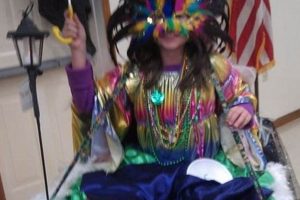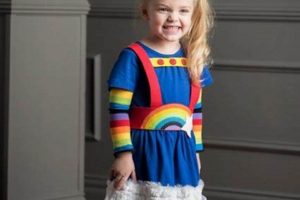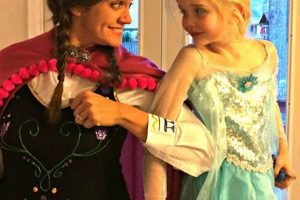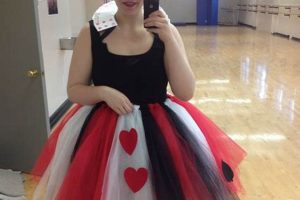Creating a personalized villainous sorceress ensemble involves constructing a unique outfit inspired by the iconic character. This often entails crafting the character’s signature horned headpiece, designing a flowing robe, and fashioning accessories such as a staff or jewelry. The process encourages creativity and allows for individual interpretations of the character’s aesthetic.
The appeal lies in the ability to tailor the design to individual preferences and budgets. Instead of purchasing a pre-made garment, one can utilize readily available materials and craft skills to produce a distinctive and often more affordable alternative. Historically, such endeavors have been a popular choice for costume parties, theatrical productions, and themed events, offering an opportunity for self-expression through handmade artistry.
The following sections will delve into specific techniques for fabricating each component of the outfit, providing guidance on material selection, construction methods, and embellishment options. These instructions will empower individuals to bring their own vision of the character to life through crafting a personalized and striking presentation.
Maleficent Costume Construction
Achieving a convincing and durable sorceress-inspired garment necessitates careful planning and execution. The following guidelines offer practical advice for a successful creation.
Tip 1: Horn Construction Integrity: Prioritize lightweight yet sturdy materials for the horned headpiece. Craft foam, wire armatures, and papier-mch offer viable options. Secure attachment to a headband or wig is crucial for stability.
Tip 2: Robe Drape and Flow: Opt for fabrics with substantial drape, such as velvet, satin, or heavy cotton blends. Consider incorporating a train for added dramatic effect. Proper hemming and finishing are essential for a polished appearance.
Tip 3: Wing Design Considerations: If including wings, prioritize lightweight materials like wire and fabric to prevent discomfort and mobility restrictions. Secure attachment mechanisms are paramount for maintaining wing stability throughout wear.
Tip 4: Makeup Application Technique: Utilize high-quality makeup products designed for theatrical use. Practice contouring and shading techniques to achieve the character’s distinctive facial features. Setting powder is crucial for preventing smudging and ensuring longevity.
Tip 5: Staff Detailing and Craftsmanship: Select a sturdy staff base, such as a wooden dowel or PVC pipe. Embellish with carefully chosen details like faux gems, feathers, or sculpted elements to enhance the visual impact. Secure attachment of decorative components is essential.
Tip 6: Color Palette Consistency: Maintain a consistent color scheme throughout the garment and accessories. Utilize shades of black, purple, green, and deep red to capture the character’s signature aesthetic. Fabric dye testing is recommended to ensure colorfastness.
Tip 7: Fabric Texture and Weight: Carefully consider the texture and weight of all chosen fabrics. Varying textures can add depth and visual interest, while appropriate weight ensures comfortable wear and proper draping.
Adherence to these tips promotes the creation of a visually appealing, durable, and comfortable garment. Careful planning and meticulous execution are vital for a successful outcome.
The subsequent section will address potential challenges encountered during the crafting process and offer solutions to overcome them, further enhancing the potential for a refined and impressive creation.
1. Horns
The horns represent a defining characteristic of the sorceress and a focal point within any associated ensemble. Their shape and texture significantly influence the overall impression of the final garment, acting as a clear indicator of craftsmanship and attention to detail. These elements directly impact the recognizability and perceived quality of the creation.
- Shape Accuracy
The curvature, length, and width of the horns must adhere, within reasonable artistic license, to the established visual canon. Deviations can dilute the character’s identity. A pronounced, upward sweep contributes to a regal and formidable presence, while overly simplistic or distorted shapes detract from the intended effect. Examples include using reference images to accurately replicate the horn’s silhouette. Ignoring accurate shaping results in misrepresentation of the character.
- Surface Texture
The surface texture conveys a sense of realism and depth. Smooth, glossy finishes project a stylized or artificial appearance, whereas textured surfaces imply age, organic growth, or even a demonic origin. The application of paint, weathering techniques, or sculpted details contribute to the final texture. Real-world examples include using textured paint or applying a faux finish to mimic bone or wood. The selected texture determines the visual weight and believability of the horns.
- Material Selection and Weight
Material choices dictate the structural integrity and visual impact. Lightweight materials prevent discomfort and ensure secure attachment, while heavier materials offer a more substantial and potentially realistic appearance. Craft foam, thermoplastics, and even 3D-printed components offer viable options, each with varying degrees of durability and ease of manipulation. Examples include using a wire armature covered in craft foam for lightweight support. Improper material selection leads to discomfort or structural instability.
- Attachment Method Security
Regardless of shape or texture, secure attachment to a headband, wig, or the wearer’s head is paramount. Unstable horns compromise the overall look and present a potential safety hazard. Straps, combs, and adhesive solutions provide varying degrees of security, depending on the weight and size of the horns. Examples include using a combination of strong adhesive and an elastic strap for secure placement. Neglecting secure attachment leads to wardrobe malfunctions and potential injuries.
The considerations of shape, texture, material and secure attachment converge to determine the impact of the horns, directly reflecting the craftsmanship inherent within the entire DIY sorceress ensemble. Effective execution of these elements elevates the project from a simple imitation to a recognizable representation of the character.
2. Robe
The robe, a central component of the sorceress-inspired creation, heavily relies on both the chosen fabric and its subsequent drape to convey character and visual impact. These elements intertwine to define the garment’s overall appearance and contribute significantly to the success of the intended portrayal.
- Fabric Weight and Texture
The weight of the selected fabri
c dictates the robe’s fall and movement. Heavier fabrics, such as velvet or brocade, create a more dramatic and imposing silhouette, while lighter materials, such as chiffon or crepe, offer a more ethereal and flowing effect. The texture further enhances the visual impact, with smooth fabrics reflecting light and creating a sleek appearance, while textured fabrics add depth and visual interest. Examples include using velvet for a regal appearance or distressed linen for a more aged, sinister aesthetic. Fabric choice determines the overall presence and perceived quality of the robe. - Drape and Silhouette Creation
The way a fabric drapes directly influences the silhouette of the robe. Bias cuts, strategic seaming, and the addition of weights can manipulate the drape to achieve the desired effect. A full, flowing drape creates a sense of grandeur, while a more fitted drape emphasizes the wearer’s form and suggests a more controlled power. Real-world examples include using a circle skirt pattern for a full drape or incorporating princess seams for a fitted bodice. Proper drape ensures the robe complements the wearer’s figure and enhances the intended character portrayal.
- Color Saturation and Light Interaction
The color of the fabric impacts how light interacts with the robe, influencing its perceived depth and dimension. Dark, saturated colors absorb light, creating a sense of mystery and foreboding, while lighter colors reflect light and create a more airy and ethereal appearance. The choice of fabric dye or pigment also affects the color’s vibrancy and longevity. Examples include using deep black velvet to create a sense of shadow or iridescent fabrics to catch and reflect light. Color plays a vital role in conveying the character’s personality and power.
- Construction Techniques and Seam Placement
The construction methods employed and the placement of seams directly impact the drape and overall appearance of the robe. Invisible seams and strategically placed darts contribute to a smoother, more polished look, while exposed seams and decorative stitching can add visual interest and texture. The type of stitching and seam finishes also affect the garment’s durability and longevity. Examples include using French seams for a clean interior finish or incorporating decorative topstitching to emphasize design lines. Quality construction ensures the robe is both visually appealing and structurally sound.
The interplay between fabric choice, drape manipulation, color saturation, and construction techniques collectively shapes the sorceress-inspired robe. Thoughtful consideration of these elements enables the creation of a garment that effectively embodies the intended character and enhances the overall impact of the completed ensemble. The robe provides a canvas upon which other components of the costume build, directly contributing to the project’s success.
3. Staff
The staff serves as a pivotal prop in a sorceress-inspired project, directly impacting the costume’s overall aesthetic and character representation. Detailing and length are key factors that contribute to the effectiveness of the staff and, by extension, the success of the entire undertaking. Insufficient detailing renders the staff generic and uninspired, diminishing the impact of the costume. Inappropriate length compromises the wearer’s posture and visual balance, potentially detracting from the overall presentation. For instance, a staff lacking intricate designs or embellishments may appear as a simple stick, failing to convey the character’s power and mystique. A staff that is excessively long may be difficult to manage and create an awkward appearance.
The staff’s detailing should reflect the character’s personality and story. Elements such as sculpted ornaments, embedded gemstones, or interwoven branches can enhance the staff’s visual appeal and provide clues about the character’s origins or magical abilities. The length should be proportional to the wearer’s height and complement the design of the robe. A taller individual may require a longer staff to maintain visual harmony, while a shorter individual may benefit from a shorter staff to avoid appearing overwhelmed by the prop. Successful integration of detailing and length results in a prop that is both visually striking and functionally practical. Consider examples such as using resin casting techniques to create intricate staff heads, adding LED lighting to create a mystical glow, or incorporating found objects like driftwood for a natural, organic look. Proper construction ensures the prop both looks great and serves its intended function.
In summary, the staff’s detailing and length are inextricably linked to the success of a sorceress-inspired project. Neglecting these aspects can result in a lackluster costume that fails to capture the character’s essence. Meticulous attention to detail and careful consideration of length can elevate the staff from a mere prop to a powerful symbol of the character’s presence and authority. Challenges may arise in sourcing appropriate materials or executing intricate designs, but these can be overcome through research, experimentation, and a commitment to craftsmanship. Prioritizing these elements contributes significantly to the creation of a compelling and memorable sorceress ensemble.
4. Wings
Wing dimensions and skeletal architecture are paramount to the recognizability and functionality of a sorceress-inspired ensemble. These features dictate the costume’s visual impact, range of movement, and overall believability within the context of a handmade design.
- Wingspan Proportionality
Wingspan should harmonize with the wearer’s physique and the overall costume design. Overly large wings may overwhelm the wearer, hindering mobility and creating an unbalanced appearance. Insufficient wingspans fail to convey the character’s commanding presence. For instance, a petite individual might benefit from a proportionally smaller wingspan to maintain aesthetic balance. The wingspan must complement the wearer, and contribute to an idealized silhouette.
- Structural Support Integrity
The internal framework dictates the wings’ shape, durability, and ability to maintain form during wear. Materials such as wire, PVC pipe, or lightweight metal offer viable options, each with varying degrees of flexibility and load-bearing capacity. Robust construction is essential to prevent sagging or collapse, especially with larger wingspans. Examples include reinforcing wire frames with fabric or utilizing a segmented design for increased flexibility. Poor structural integrity impairs the wings’ aesthetic and poses a potential safety risk.
- Weight Distribution and Ergonomics
Uneven weight distribution can lead to discomfort and strain, particularly during extended wear. Lightweight materials and strategic placement of support structures are crucial for minimizing fatigue. Attachment mechanisms, such as harnesses or straps, should distribute weight evenly across the wearer’s shoulders and back. Real-world examples include using padded straps and adjustable closures for a comfortable and secure fit. Improper weight distribution detracts from the wearer’s experience and compromises the costume’s functionality.
The interplay of wingspan proportionality, structural support integrity, and weight distribution critically impacts the overall effectiveness o
f a sorceress-inspired creation. A well-executed design balances visual impact with functionality, ensuring the wings enhance the costume without hindering the wearer’s mobility or comfort. The implementation of these elements results in a visually compelling and practically wearable prop.
5. Makeup
The strategic application of contour and color significantly contributes to the realization of a convincing sorceress-inspired character. This aspect of the overall crafting project warrants careful consideration due to its direct influence on the visual impact and character portrayal.
- Facial Sculpting Through Shadow and Light
Contouring techniques manipulate shadows and highlights to reshape facial features, emphasizing bone structure and creating a more angular, defined appearance. The use of darker shades in hollows and lighter shades on prominent areas creates the illusion of depth and dimension. In the context of a sorceress-inspired design, this might involve accentuating cheekbones and sharpening the jawline to convey a sense of power and severity. Examples include using cool-toned contour shades to mimic the look of sunken cheeks or applying a matte highlighter to the brow bone to create a more dramatic arch. Accurate contouring elevates the costume beyond a simple imitation, creating a unique representation of the character.
- Color Palette Selection for Character Emphasis
The selection of appropriate colors enhances the character’s specific characteristics and reinforces the costume’s overall theme. A pale complexion, often achieved through foundation and powder, creates a stark contrast with darker accents, contributing to a dramatic effect. Strategic use of color, such as deep reds or purples for the lips and eyes, amplifies the sense of mystery and malevolence. Examples include using a cool-toned grey eyeshadow to enhance the character’s eyes, or using a dark lipstick shade to enhance the character’s dark side. The consistent application of specific colors enhances recognition of the intended figure.
- Blending and Gradation Techniques for Realism
Seamless blending of different shades ensures a smooth transition between colors, preventing harsh lines and creating a more natural and believable appearance. Gradation techniques involve layering and blending colors to create depth and dimension, adding realism to the makeup application. In the context of a sorceress-inspired design, this might involve blending dark eyeshadow shades to create a smoky effect or using a gradient lip technique to add dimension to the lips. Examples include using a makeup sponge to blend out harsh lines or using a brush to layer colors for a seamless transition. Proper blending creates a convincing application.
- Longevity and Durability Considerations
The selection of long-wearing, high-quality makeup products ensures that the application withstands the rigors of wear, maintaining its integrity throughout extended periods. Setting sprays and powders help to lock in the makeup and prevent smudging or fading. In the context of a sorceress-inspired creation, this is particularly important, as the makeup often involves complex techniques and dramatic color combinations. Examples include using a waterproof mascara to prevent smudging and using a setting spray to keep the makeup in place. Consideration for product longevity ensures visual cohesion.
The successful execution of contouring and color techniques represents an integral component of a completed sorceress-inspired design. Through these methods, the wearer effectively assumes the character, strengthening the visual impact and ensuring that the persona is convincingly represented. Careful attention to detail during this process helps to elevate the overall appearance and creates a lasting impression.
6. Accessories
The selection of appropriate jewelry directly impacts the overall aesthetic cohesion and character representation within a sorceress-inspired ensemble. Jewelry choices can reinforce the character’s background, amplify specific design elements, and contribute to a polished, believable final product.
- Material Selection and Symbolic Association
Material choices, such as metals, stones, and embellishments, carry symbolic weight and enhance the costume’s narrative. Darkened metals, like blackened silver or antiqued bronze, evoke a sense of age and mystery, while simulated gemstones in deep greens and purples resonate with the character’s color palette. The inclusion of specific symbols, such as ravens or thorns, reinforces the sorceress’s connection to nature and her darker inclinations. Real-world examples include crafting a pendant featuring a raven skull or incorporating thorn-like designs into a ring. Jewelry should not only complement but also narrate the character’s story. Ill-considered selections may clash with the overall design, diminishing the costume’s intended impact.
- Scale and Proportion in Relation to the Costume
The size and proportion of jewelry items relative to the costume’s overall scale are essential for achieving visual harmony. Overly large or ornate pieces can overwhelm the wearer and detract from other key design elements, such as the robe or horns. Conversely, excessively small or understated jewelry may go unnoticed, failing to contribute to the costume’s aesthetic. Examples include selecting a delicate necklace to complement a high neckline or choosing a statement ring to draw attention to a specific gesture. Jewelry scale must balance with the overall garment to achieve the intended presence. Disproportionate components produce a fragmented and jarring visual effect.
- Crafting Techniques and DIY Adaptability
The chosen jewelry should align with the creator’s skill level and access to tools and materials. Simple crafting techniques, such as wire wrapping, bead stringing, and polymer clay sculpting, offer accessible avenues for creating custom pieces. The repurposing of existing jewelry items, such as adding embellishments or altering their finish, provides an economical and creative approach. Examples include using wire to create a twisted choker or painting existing beads to match the costume’s color scheme. Successful homemade adaptations allow the costume to exhibit unique aspects. Conversely, attempting overly complex techniques without the requisite skills can result in unsatisfactory results.
- Historical and Thematic Accuracy
When aiming for a specific historical or thematic inspiration, jewelry choices must adhere to the established visual conventions of that era or genre. For instance, a sorceress inspired by medieval folklore may necessitate jewelry featuring Celtic knots or heraldic motifs, while a more modern interpretation might incorporate geometric designs or futuristic materials. Real-world examples include researching historical jewelry styles to inform design choices or drawing inspiration from fantasy literature and art. Adherence to established visual language conveys intended meaning, thus making the portrayal clearer. Ignoring visual precedents causes confusion or a loss of a source material’s significance.
Thoughtful integration of jewelry choices enhances the overall impact of a sorceress-inspired creation, reinforcing the character’s identity and elevating the costume from a simple garment to a compelling vis
ual narrative. The selection of appropriate materials, scale, and crafting techniques, combined with a keen awareness of historical or thematic accuracy, ensures that the jewelry contributes to a cohesive and memorable presentation. Improper selection distracts from the main focus, thus detracting from the garment’s impact.
Frequently Asked Questions
This section addresses common inquiries and concerns encountered during the process of constructing a sorceress-inspired garment. The information provided aims to clarify potential ambiguities and offer practical solutions.
Question 1: What materials are most suitable for crafting the horned headpiece?
Durable, lightweight materials such as craft foam, thermoplastics, or papier-mache offer viable options. The selection should consider both ease of manipulation and structural integrity. A wire armature may be incorporated for added support.
Question 2: How can a flowing and dramatic drape be achieved for the robe?
Fabrics with inherent drape, such as velvet, satin, or heavy crepe, are recommended. Bias cuts and strategic seaming can further enhance the drape. Adding weights to the hem can improve the garment’s fall.
Question 3: What are the key considerations for constructing wings that are both visually impressive and comfortable to wear?
Prioritize lightweight materials such as wire and fabric. Secure attachment mechanisms are crucial for stability. Distribute the weight evenly across the wearer’s shoulders and back to minimize strain.
Question 4: How can a convincing makeup application be achieved to emulate the character’s distinctive facial features?
Utilize high-quality makeup products designed for theatrical use. Practice contouring and shading techniques to accentuate bone structure. Setting powder is essential for preventing smudging and ensuring longevity.
Question 5: What are the essential factors to consider when detailing the staff to enhance its visual impact?
Select a sturdy staff base, such as a wooden dowel or PVC pipe. Embellish with carefully chosen details, such as faux gems, feathers, or sculpted elements. Ensure secure attachment of all decorative components.
Question 6: How can color consistency be maintained throughout the garment and accessories?
Establish a consistent color scheme using shades of black, purple, green, and deep red. Conduct fabric dye tests to ensure colorfastness. Utilize color charts to match shades across different materials.
In summary, careful material selection, meticulous construction techniques, and a commitment to detail are essential for crafting a visually appealing and durable sorceress-inspired garment. Addressing these common inquiries provides a foundation for a successful creation.
The subsequent section will explore advanced techniques for embellishing and personalizing the garment, further enhancing its uniqueness and visual impact.
Conclusion
The preceding exploration has delineated essential aspects of constructing a “maleficent costume diy.” From the horned headpiece to the flowing robe, strategic makeup application, and detailed staff construction, each element contributes to the overall visual impact. Careful attention to material selection, structural integrity, and proportional considerations ensures a cohesive and recognizable representation.
The pursuit of crafting such a costume, therefore, extends beyond mere replication. It is an exercise in artistic interpretation, demanding both technical skill and a commitment to detail. The ability to transform raw materials into a compelling embodiment of a powerful character signifies a dedication to craftsmanship and a profound appreciation for the art of costuming. The undertaking represents a challenging yet rewarding endeavor for those seeking to express creativity and embody a transformative persona.







